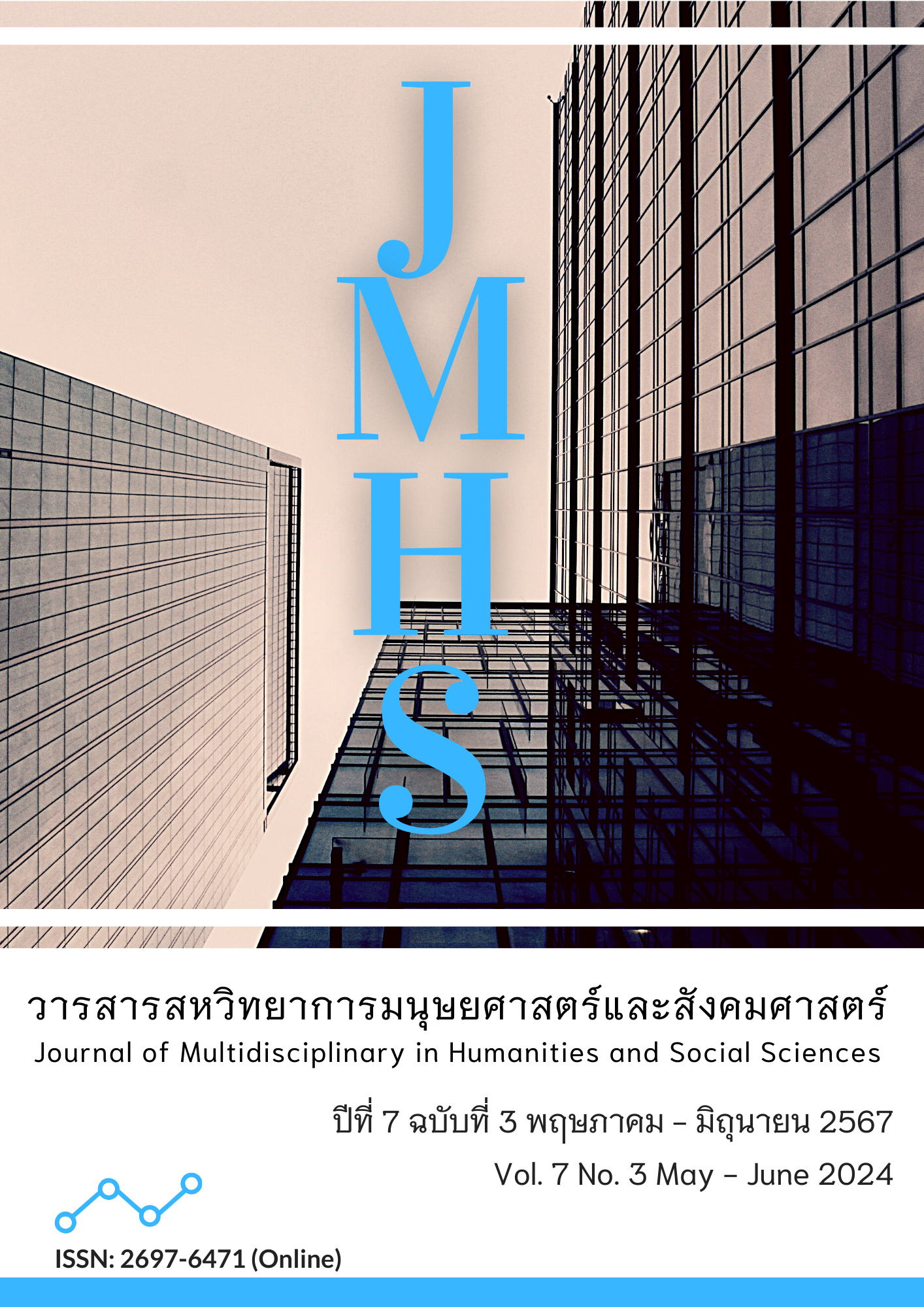Model of Innovative Leadership Based on Papanika Dhamma for School Administrators under Office of Primary Educational Service Area
Main Article Content
Abstract
The objectives of this research were: 1) to study the need for innovative leadership among educational institution administrators under the Office of the Primary Educational Service Area; 2) to develop an innovative leadership model based on the principles of Papanika Dhamma for educational institution administrators under the Office of the Primary Educational Service Area; and 3) to evaluate the innovative leadership model according to the principles of Papanika Dhamma for educational institution administrators under the jurisdiction of the Primary Educational Service Area Office. It was a combined method of research. There were 3 research steps: Step 1: To study the needs and necessities for innovative leadership among educational institution administrators by using a questionnaire on a sample of 368 teachers, the data were analyzed using basic statistics, namely, percentage, mean, standard deviation, and the index of essential needs. Step 2: To develop a model by interviewing 10 key informants and organizing group discussions with 9 experts. Research tools included an interview form and question guidelines for group discussions. The data were analyzed using content analysis. And step 3: To evaluate the model by using an evaluation form with a sample of 310 educational institution administrators, the data were analyzed using basic statistics, namely, percentage, mean, and standard deviation.
It was found that: 1. There was a need for innovative leadership among educational institution administrators under the jurisdiction of the Primary Educational Service Area Office overall, with an index of essential needs between 0.055 - 0.076. The element with the highest need was innovative vision, followed by innovative creativity, courage to take innovative risks, and transformational leadership, respectively. 2. An innovative leadership style according to the principles of Papanika Dhamma for educational institution administrators under the jurisdiction of the Primary Educational Service Area Office consists of five elements: Component 1: Principles: Educational institution administrators used management methods integrated with Buddhist principles and innovative leadership to develop educational institutions. Component 2: Objective: This was a guideline for educational institution administrators to apply the principles in their administration for greater efficiency and effectiveness. Component 3: Integrating innovative leadership (vision, innovation) according to the principles of Papanika Dhamma, namely, 1) Cakkhuma, having wisdom and foresight; 2) Vidhuro, having good management; and 3) Nissayasampanno, having good human relations. Component 4: Application in the administration of educational institutions in 4 areas: academic administration, personnel management, budget management, and general administration. And Element 5: Evaluation. 3. Evaluation of innovative leadership styles according to the principles of Papanika Dhamma for educational institution administrators under the jurisdiction of the Primary Educational Service Area Office Overall, the evaluation results were at the highest level in all 4 areas: usefulness, correctness, feasibility, and appropriateness, respectively. A summary of research knowledge is concluded in PAKWILAI.
Article Details

This work is licensed under a Creative Commons Attribution-NonCommercial-NoDerivatives 4.0 International License.
Views and opinions appearing in the Journal it is the responsibility of the author of the article, and does not constitute the view and responsibility of the editorial team.
References
ขวัญชนก โตนาค, สุกัญญา แช่มช้อย และ อนุชา กอนพ่วง. (2557). การวิเคราะห์องค์ประกอบภาวะผู้นำเชิงนวัตกรรม สำหรับผู้บริหารสถานศึกษาขั้นพื้นฐาน. Journal of Education Naresuan University, 16(4), 131–140.
จีระศักดิ์ นามวงษ์ และ พชรวิทย์ จันทร์ศิริสิร. (2563). การพัฒนาโปรแกรมเสริมสร้างภาวะผู้นำเชิงนวัตกรรมของผู้บริหารสถานศึกษา สังกัดสำนักงานเขตพื้นที่การศึกษาประถมศึกษาศรีสะเกษ เขต 1. วารสารมหาจุฬานาครทรรศน์, 7(6), 338-352. https://so03.tci-thaijo.org/index.php/JMND/article/view/244554
ฐิตินันท์ นันทะศรี, วาโร เพ็งสวัสดิ์, วัลนิกา ฉลากบาง และ พรเทพ เสถียรนพเก้า. (2562). การพัฒนาตัวบ่งชี้ภาวะผู้นำเชิงนวัตกรรมของผู้บริหารสถานศึกษา สังกัดสำนักงานเขตพื้นที่การศึกษาประถมศึกษา ในภาคตะวันออกเฉียงเหนือ. วารสารวิชาการและวิจัยสังคมศาสตร์, 14(3), 93-106. สืบค้นจาก https://so05.tci-thaijo.org/index.php/JSSRA/article/view/203176
ธวัชชัย รัตตัญญู. (2551). การพัฒนารูปแบบการบริหารโดยใช้โรงเรียนเป็นฐานในโรงเรียนสังกัดองค์กรปกครองส่วนท้องถิ่น(ดุษฎีนิพนธ์ปรัชญาดุษฎีบัณฑิต). มหาวิทยาลัยสยาม.
บุญชม ศรีสะอาด. (2535). การวิจัยเบื้องต้น. กรุงเทพฯ: ชมรมเด็ก.
พยัค วุฒิรงค์. (2557). การจัดการนวัดกรรม. กรุงเทพฯ: จุฬาลงกรณ์มหาวิทยาลัย.
พระธรรมโกศาจารย์ (ประยูร ธมฺมจิตฺโต). (2549). พุทธวิธีการบริหาร. กรุงเทพฯ: มหาจุฬาลงกรณราชวิทยาลัย.
พระพรหมคุณาภรณ์ (ป. อ. ปยุตฺโต). (2548). พจนานุกรมพุทธศาสตร์ ฉบับประมวลธรรม. (พิมพ์ครั้งที่ 13). กรุงเทพฯ: สหธรรมมิก.
พระมหาญาณวัฒน์ ฐิตวฑฺฒโน และ ศุขภิญญา ศรีคำไทย. (2565). การบูรณาการหลักพุทธธรรมกับสมรรถนะของผู้บริหารสถานศึกษา. วารสารบวรสหการศึกษาและมนุษยสังคมศาสตร์, 3(1), 70-78. สืบค้นจาก https://so03.tci-thaijo.org/index.php/JOB_EHS/article/view/258569
พัชรี ชำนาญศิลป์. (2557). ภาวะผู้นำเชิงพุทธ(ดุษฎีนิพนธ์พุทธศาสตรดุษฎีบัณฑิต). มหาวิทยาลัยมหาจุฬาลงกรณราชวิทยาลัย.
พัฐณสิญ นวโลจิตรัตน์. (2560). รูปแบบการพัฒนาคุณลักษณะผู้นำแบบไทยอันพึงประสงค์ของผู้บริหารสถานศึกษา สังกัดสำนักงานเขตพื้นที่การศึกษามัธยมศึกษา ภาคกลาง(ดุษฎีนิพนธ์พุทธศาสตรดุษฎีบัณฑิต). มหาวิทยาลัยมหาจุฬาลงกรณราชวิทยาลัย.
พิสิฐธวัฒน์ กลิ่นไธสงค์, ถนอมวรรณ ประเสริฐเจริญสุข และ อัจศรา ประเสริฐสิน. (2559). การพัฒนาตัวบ่งชี้ภาวะผู้นำเชิงนวัตกรรมของผู้บริหารโรงเรียนมัธยมศึกษา สังกัดสำนักงานเขตพื้นที่การศึกษามัธยมศึกษา. วารสารบริหารการศึกษา มหาวิทยาลัยขอนแก่น, 12(1), 177-186. สืบค้นจาก https://so02.tci-thaijo.org/index.php/EDMKKU/article/view/56374
มหาจุฬาลงกรณราชวิทยาลัย. (2539). พระไตรปิฎกภาษาไทย ฉบับมหาจุฬาลงกรณราชวิทยาลัย. กรุงเทพฯ: มหาจุฬาลงกรณราชวิทยาลัย.
ราชัญ สมทบ. (2566). การพัฒนารูปแบบการบริหารการจัดการเรียนรู้ฐานวิถีชีวิตใหม่ เพื่อยกระดับคุณภาพผู้เรียน โรงเรียนพื้นที่นวัตกรรมการศึกษาจังหวัดกาญจนบุรี. วารสารนวัตกรรมการจัดการศึกษาและการวิจัย, 5(3), 659-672. สืบค้นจาก https://so02.tci-thaijo.org/index.php/jemri/article/view/261022
วันทนา เนาว์วัน. (2558). การพัฒนาภาวะผู้นำตามหลักพุทธธรรมของบุคลากรโรงเรียนพระปริยัติธรรม แผนกสามัญศึกษา กลุ่ม 3(ดุษฎีนิพนธ์พุทธศาสตรดุษฎีบัณฑิต). มหาวิทยาลัยมหาจุฬาลงกรณราชวิทยาลัย.
สาลินี มีเจริญ, สุบิน ยุระรัช และ อรรณพ จีนะวัฒน์ . (2556). การพัฒนากลยุทธ์ในการบริหารความเสี่ยงของผู้บริหารสตรีในโรงเรียนมัธยมศึกษา สังกัดสำนักงานคณะกรรมการการศึกษาขั้นพื้นฐาน. วารสารศึกษาศาสตร์ มหาวิทยาลัยนเรศวร, 15(3), 40-50. สืบค้นจาก https://so06.tci-thaijo.org/index.php/edujournal_nu/article/view/16049
สุกัญญา แช่มช้อย. (2555). แนวคิดเชิงนวัดกรรมสำหรับการบริหารสถานศึกษาในสตวรรษที่ 21. วารสารศึกษาศาสตร์ มหาวิทยาลัยนเรศวร, 14(2), 117-128. สืบค้นจาก https://so06.tci-thaijo.org/index.php/edujournal_nu/article/view/9391
สุนทร โคตรบรรเทา. (2560). การบริหารการศึกษาหลักการและทฤษฎี. กรุงเทพฯ: ปัญญาชน.
สุรีรัตน์ ยอดบุรี และ นิคม นาคอ้าย. (2565). การศึกษาปัญหาและแนวทางพัฒนาการบริหารหลักสูตรสถานศึกษาของโรงเรียนขนาดเล็กสังกัดสำนักงานเขตพื้นที่การศึกษาประถมศึกษากำแพงเพชร เขต 1. Journal of Roi Kaensarn Academi, 7(1), 289-303. สืบค้นจาก https://so02.tci-thaijo.org/index.php/JRKSA/article/view/251628
อภิชญาณัฐโศภา อบสิน. (2557). รูปแบบการพัฒนาภาวะผู้นำเชิงพุทธในการบริหารจัดการองค์กรของมหาวิทยาลัยมหาจุฬาลงกรณราชวิทยาลัย(ดุษฎีนิพนธ์พุทธศาสตรดุษฎีบัณฑิต). มหาวิทยาลัยมหาจุฬาลงกรณราชวิทยาลัย.
อภิรักษ์ บุปผาชื่น. (2563). ภาวะผู้นำเชิงนวัตกรรม: การขับเคลื่อนองค์การสู่ความเป็นเลิศ. วารสารนวัตกรรมการศึกษาและการวิจัย, 4(3), 205-216. สืบค้นจาก https://so03.tci-thaijo.org/index.php/jeir/article/view/247139
Adair, J. E. (2007). Leadership for Innovation: How to Organize Team Creativity and Harvest Ideas. London: Kogan Page Publishers.
Dyer, J., Gregersen, H., & Christensen, C. M. (2011). The Innovator's DNA: Mastering the Fine Skills of Disruptive Innovators. Boston: Harvard Business Press.
Krejcie, R. V., & Morgan, D. W. (1970). Determining Sample Size for Research Activities. Educational and Psychological Measurement, 30(3), 607-610. https://doi.org/10.1177/00131644700300030
Likert, R. (1967). The Method of Constructing and Attitude Scale. In Reading in Attitude Theory and Measurement. Fishbeic, M., Eds. New York: Wiley & Son.
Sen, A., & Erena, E. (2012). Innovative Leadership for the Twenty-First Century. Procedia - Social and Behavioral Sciences, 41, 1-14. https://doi.org/10.1016/j.sbspro.2012.04.001


